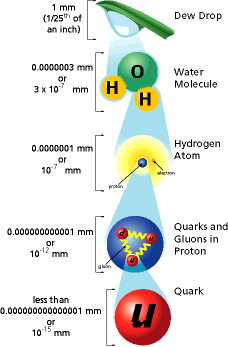 |
Run II Discovery |

|
The Standard Model
What is Fermilab? - Run II Newscasts - Analyze the Data - Particle Physics Bibliography
|
A dew drop is made up of many molecules of water (1021 or a billion trillion). Each molecule is made of an oxygen atom and two hydrogen atoms (H2O). These atoms are made up of elementary particles found in the first generation of the Standard Model. Each atom consists of a nucleus surrounded by electrons. Electrons are leptons that are bound to the nucleus by the electromagnetic force, mediated by photons (gamma in the chart), which are bosons. The nucleus of a hydrogen atom is just a single proton. Protons consist of three quarks: 2 up quarks, each with charge +2/3, and 1 down quark, with charge -1/3. (Add up the charges of the quarks to get the proton charge.) In the proton, the strong nuclear force, mediated by bosons called gluons (g), hold the quarks to each other just as photons hold the electron to the nucleus in the atom. So there it is: a nice, simple, neat package that describes matter as we understand it . . . and it is full of mysteries. One of the biggest is: Why do fundamental particles have mass at all? What gives them this property? The answer may exist in a particle we've never observed but we think might be hiding in the higher number of particle collisions that Run II will explore. It is called the Higgs boson: the exchange particle that mediates the property of mass. |
 |
Project Contact: Thomas Jordan - jordant@fnal.gov
Web Maintainer; qnet-webmaster@fnal.gov
Last Update: September 22, 2000
/run2/standard2.html